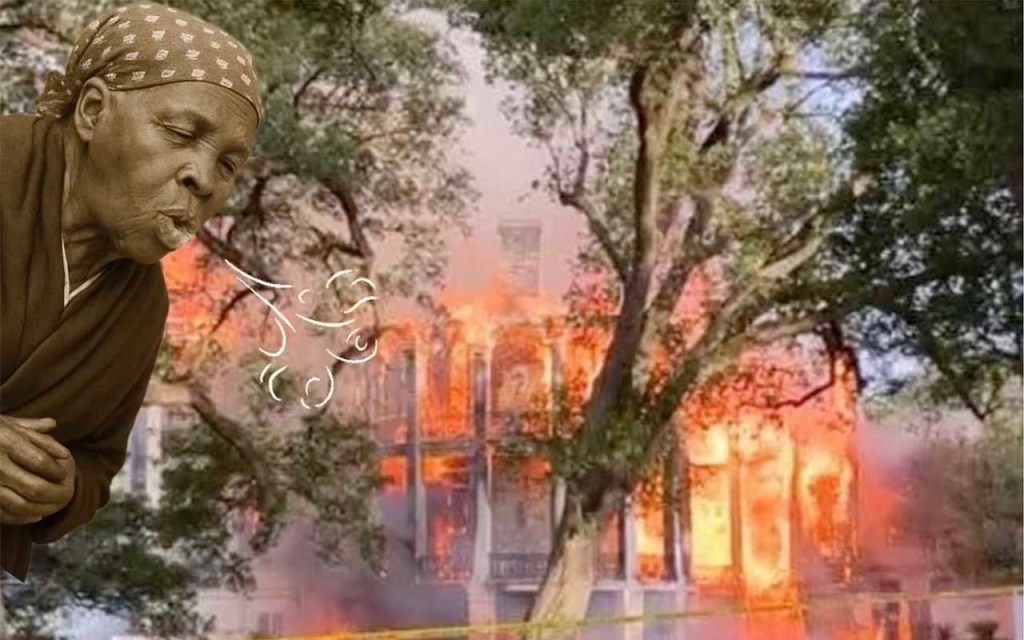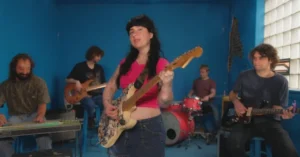Let It Burn


When Nottoway Plantation burned to the ground last week, I felt something strange but familiar: relief—a kind of exhale I didn’t know I was holding. Black people across the internet seemed to feel it, too, fanning the flames with memes, one-liners, and side-eyed reverence. The feeling wasn’t cruel or careless. It was cathartic. When a plantation burns, it’s not just a building reduced to ash. It’s a monument to American mythology collapsing under the weight of its own lies.
The largest remaining antebellum mansion in the South — marketed as a resort, wedding venue, and architectural “treasure” — is gone. And for many of us, it couldn’t have happened at a more symbolic time. There’s something almost spiritual about the way it fell, something cosmically corrective. A book of propaganda made out of brick and stone, finally catching fire.
Plantations like Nottoway aren’t just remnants of history. They’re scripts. Stories written in sugar and cotton and enforced through spectacle. The house’s grandeur — its white columns, endless rooms, and curated tours — was designed to tell a version of the past that privileged grace over grief, aesthetics over atrocity. The enslaved people who built the estate were footnotes, mentioned quickly and framed delicately, so as not to disturb the fantasy. That fantasy, of course, was always meant for someone else.
There’s a similar choreography at work in other places I’ve written about. The art fair that prioritizes spectacle over story. The academic institution that demands our presence but punishes our refusal to assimilate. The gallery that puts us on the wall but not at the table. These aren’t isolated sites of tension — they’re iterations of the same logic: Package the pain, scrub the context, sell the image. And when the image threatens to speak back, reframe it or burn it out of the archive.
That’s what makes the timing of the fire feel so potent. We’re in a cultural moment where the erasure of Black history is both figurative and literal. Books banned. Lessons censored. Critical race theory turned into a political scarecrow. What’s happening in schools and libraries mirrors what’s long been happening in architecture: the active, strategic construction of silence. The plantation is just an older version of the same trick. If you control the narrative, you control the memory. If you control the memory, you control the future.
This isn’t just theoretical. The aesthetics of oppression are incredibly effective at disarming critique. Nottoway didn’t need to defend itself; it just needed to stand there. Its beauty was the alibi. That’s why its destruction feels so deeply satisfying. Not because it’s destruction, but because it’s disruption. A system of myth-making collapsed in real time.

And that collapse reminded me of Kara Walker’s “A Subtlety” (2014) at the Domino Sugar Factory in Brooklyn, New York. A towering sugar sphinx with exaggerated African features, installed in a space saturated with the ghosts of labor and extraction. I remember being awestruck by the scale of it, the brilliance of it — but more than that, I remember what happened around it. Visitors are taking selfies, groping the sculpture, and joking about it online. The way White audiences felt entitled not just to witness, but to possess. The way Black viewers found themselves having to defend the dignity of the work in real time. What Walker created wasn’t just a sculpture — it was a trap. A performance of the performance.
In a way, the plantation does the inverse. It invites you in with softness, with grace, with magnolia-scented romance. But it’s performing too. It’s staging a version of the past that deliberately omits the terror. And just like “A Subtlety,” the behaviors it draws out from viewers reveal something profound. That history isn’t behind us. It’s ambient. It’s scripted into our gestures, our habits, our sense of what is beautiful and what is not. And often, it’s acted out without even thinking.

What haunted me most at Walker’s installation — and what still haunts me now — was not just the groping or the photos, but the ease with which they happened. No hesitation. No awareness. Just the seamless reenactment of a script. That is what terrifies me: not the spectacle of racism, but its reflex. The way it animates bodies without pause. As if history is not just remembered, but physically inherited. Passed down like choreography. We often talk about systemic violence as something abstract, institutional. But what if it’s closer to muscle memory?
And so it makes sense that so many of these spaces — plantations, sugar factories, galleries, schools — are bound by architecture. Architecture makes it easier to forget. Its scale impresses. Its beauty distracts. It allows violence to harden into form, and then demands our reverence. These structures are not just sites — they are scripts. And when people step into them, they play their roles. The fact that they don’t even realize it — that’s the horror. That’s the point.
Which is why the fire at Nottoway struck such a deep chord. For Black people, it wasn’t just the fall of a building. It was a release. The knot loosened. The silence broken. The spell interrupted. Watching it burn felt like witnessing a lie collapse under the weight of truth.
There is something delicious about that feeling. Not petty. Not vindictive. Something rooted. Something ancestral. We’re so used to seeing the symbols of our oppression protected, restored, even monetized. So when one falls — especially this one — it feels like the past acknowledging itself. Like the ancestors finally flipping the switch.
I don’t think it’s wrong to feel joy in that moment. I think it’s honest. I think it’s necessary. That joy isn’t about fire — it’s about what the fire frees.
And it does beg the question: What now? If the plantation is gone, what do we build in its place? Not just literally, but symbolically. What happens when the myth is no longer available to hide behind? Who gets to write the next chapter?
Because the real work starts there. The clearing must be followed by the planting. The collapse by the reimagining. We can’t build a future worth living in if we’re still living in someone else’s lie. So yes, let it burn. But also — let’s build the thing that tells the truth. Let’s write the curriculum, fund the archives, support the artists and scholars, and organizers who are laying down blueprints for what comes next.
Because that fire? That wasn’t the end of anything. That was the beginning. The plantation was a fiction. A stage set. And now that the curtain has come down, we are left with something rare: a cleared foundation. A space where something truer might finally be constructed — not in spite of the burn, but because of it.





